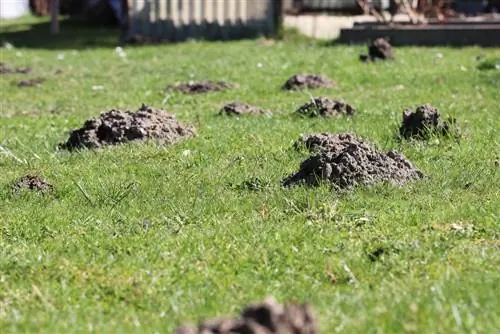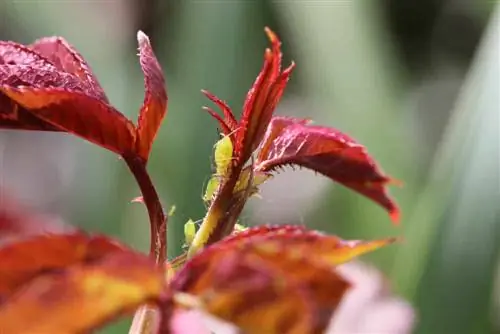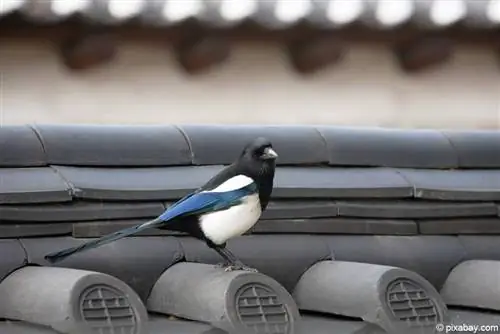- Author admin [email protected].
- Public 2023-12-17 03:39.
- Last modified 2025-06-01 06:48.
Mice, especially house and forest mice, have always been found in people's houses and gardens as cultural followers. For this reason, they are one of the most common pests, especially in rural areas, and it is therefore necessary to have a suitable means of repelling the small mammals. But not all of them are really effective.
Remedies against mice
A variety of means and options are offered to drive away the rodents. The methods below ensure that the mice are only driven away and not necessarily brutally killed. Apart from the use of a cat, of course, the best mouse catcher in the world. Please note that many of the methods need to be used over a longer period of time. to bear fruit. The following tips can also help to contain the infestation immediately:
- store all food in lockable containers
- place garbage cans as far away from the house as possible
- clean your living spaces and the garden thoroughly so as not to provide more nesting opportunities for the animals
- do not leave pet food open to dogs, cats or other rodents
This allows you to effectively prevent a plague of mice, as the animals are primarily attracted by food. The less food they find, the less interested they are in your living spaces. The same applies to the garden, because mice like to spread through gardens into houses if they can get food here. For example, rodents love bird food and are easily attracted to it. If you then find shelter nearby, it won't be long before they find a crack or passage through which they can get into the house.
Ultrasound
In recent years, ultrasonic devices have become increasingly popular for driving away mice. These are electrically operated devices that produce an ultrasonic noise that is inaudible to humans. This is kept at a frequency that is uncomfortable for the mice and for this reason they should no longer stay within the effective radius specified by the manufacturer. In general, this concept sounds pretty good, as high frequencies hurt and it makes sense that the animals avoid the radius. The following values for the devices are important:
- Effective area in m²: 25m² is recommended for individual rooms and over 100m² for the garden
- Frequency range in kHz: 30 - 65 kHz is recommended here
- Number of speakers: one speaker is sufficient in most cases
- Sound pressure in dB: varies depending on the manufacturer, 160 dB is usually the maximum
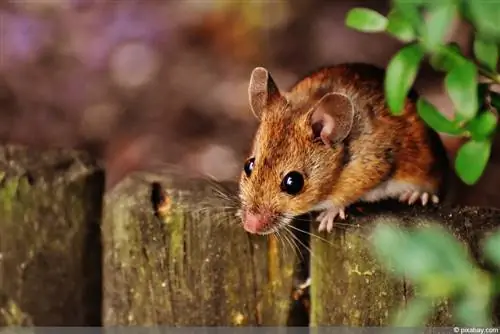
There are already several devices on the market, with costs ranging from ten to 60 euros. These differ greatly in quality and for this reason you should definitely compare them before making a purchase. Ultrasound machine manufacturers include:
- Plaguebye
- Gardigo
- Weitech
Depending on the manufacturer, these devices actually work quite well, but often not in the specified range of effectiveness. Especially in buildings, the masonry significantly reduces the strength of the frequency and thus ensures an unsatisfactory result. However, the devices work very well in individual rooms. You can place the device in one of the rooms where the mice are and after a few days they no longer dare to go there. However, you must keep in mind: the smaller the room, the more effective the ultrasound device. Ultrasonic devices are particularly recommended for the pantry, as they have the greatest possible effect here. They can also be used in the garden, as in most cases the signal is not interrupted by walls or building structures. This means that the larger effective area is primarily intended for the garden.
Tip:
Some of these ultrasound devices even work against annoying insects such as mosquitoes. This makes them doubly effective, as you can also protect yourself from the bites of bloodsuckers.
Cats
Cats are by nature the best way to effectively drive away mice and in many cases reduce their numbers. This variant is the only one in the list that is fatal to the animals, but these cannot be compared with classic mousetraps. A cat works effectively against the mouse population within the house and garden and is extremely successful at this, as they have been domesticated for this task over a period of several millennia. However, there are a few points you need to keep in mind when using cats, especially if you live in the country or your cat is an outdoor cat:
- female cats should be sterilized
- this prevents the chance of a possible pregnancy
- Depending on the size of the property, at least two cats are recommended
- The purchase of kittens is not a problem as it increases the hunting instinct early on
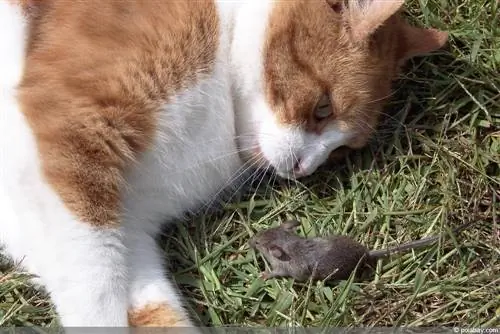
You can theoretically let cats hunt mice on their own. However, you have to be aware that there are cats that don't have a strong hunting instinct. However, just the presence of a cat can drive away the mice, as they know their predators. You can use your pet’s cat litter for this. Mice avoid the smell of cat urine and for this reason it is advisable to use this fear against them. Fill a little used cat litter into a bag and place it in the areas or paths the mice have already visited. Do not seal the bag. The longer you use this method, the faster the rodents will take off.
Tip:
When using the cat litter method, it is important to ensure that you always keep your cat's litter box clean. If the actual litter box is no longer accessible in the cat's eyes, they tend to look for these bags in an emergency, which can lead to a big mess.
Turpentine
As you've probably noticed by now, mice are sensitive to smells. You should take advantage of this and use turpentine as a home remedy. The strong smell of turpentine immediately reaches the sensitive noses and ensures that the mice avoid the places where they smell the resinous discharge. When using, follow the steps below:
- locate the mouse holes first
- now soak cotton cloths with turpentine
- alternatively, you can fill turpentine into a flat glass and dip the cotton cloth into it
- now place the cloths directly in front of the holes
- It's best to plug the holes with the cloths so that the mice have no opportunity to get into the living rooms
- the more you use the wipes, the larger the area of effect becomes
Turpentine is available for around five to 15 euros per liter, depending on the quality. The more intense the smell, the more effective this method is and the mice will retreat more and more from the living spaces. It helps if you place cloths in front of rodents' entrances into the house if you know where they are. As a result, they no longer dare to go past them and look for somewhere else to stay outside.
Plants, oils and spices against mice
Mice can also be reliably driven away with fragrant plants, their oils, herbs and spices. The following are particularly suitable for this method:
- fresh peppermint (bot. Mentha piperita) or its oil
- fresh chamomile (bot. Matricaria chamomilla) or its oil
- fresh mint (bot. Mentha spicata) or its oil
- Eucalyptus oil
- Cayenne pepper
- Chili flakes
- Cloves
- Oleander leaves
Use the oils in the same way as using turpentine and simply place the soaked cloths directly in front of the hole. You can sprinkle chili flakes as well as cloves and oleander leaves in front of the holes and along the paths of the small rodents. Repeat this procedure every week to see lasting results. You should change the oil weekly or sprinkle the cloths with fresh oil so that the effect does not wear off. The reason for this is the mice's sense of smell. If the smell of the oil or the amount of spices sprinkled decreases, the rodents notice this and sneak past them because this area is now easier for them to walk on again. So the rule here is: the more, the better!
Live Traps
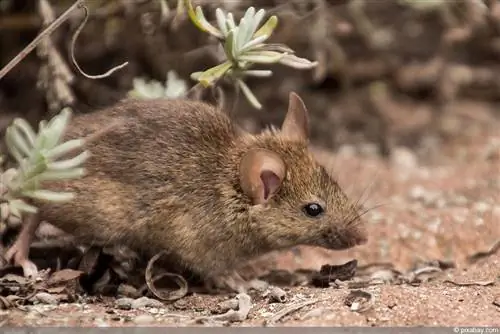
Live traps are an effective method, but very time-consuming. As with the well-known snap traps, the animals are attracted with bait and then caught in the cage as soon as they grab the bait. They must remain there until you release them again. When using live traps, you must ensure that you check the traps at least every twelve hours and release caught mice outdoors. The mice must be released at least 500 meters from your house and property so that they do not find their way back to their colony. Depending on the size of the colony, you may need to use multiple traps or empty them two to three times a day. The costs are between ten and 20 euros per trap.
Incense
Incense is just as effective against animals as plants, spices and oils. The incense products should be used primarily in attics or cellars, otherwise you will smoke yourself out because you have to use a lot of incense sticks for this. Choose incense sticks that you like and place them at the mouse holes or in the immediate vicinity of mouse burrows. Alternatively, you can use incense for this, but incense sticks are much more handy and cheaper at the same time. Above all, the use makes incense sticks much more effective than incense, as they are easy to set up and don't even have to be dosed. Incense sticks are also cheaper, at 50 cents to 2 euros per pack, while 100 grams of incense costs around ten euros, plus other accessories.


